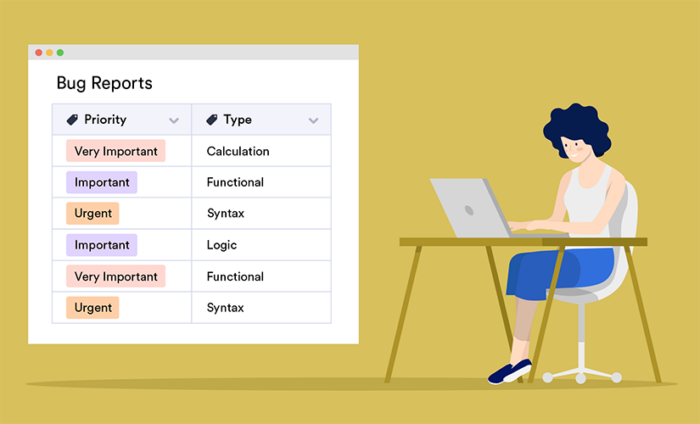Common types of software bugs and errors
Coming up with a brilliant software solution takes lots of testing and tweaking. Throughout this process, you’re bound to come across error messages and other development roadblocks. When you know the different types of software bugs you’re likely to encounter, you’ll also know the best approaches to fixing them.
Keep reading to learn about common bugs you may have to deal with in the software development process.
1. Functional errors
This is a broad type of error that happens whenever software doesn’t behave as intended. For example, if the end user clicks the “Save” button, but their entered data isn’t saved, this is a functional error. After some investigation, a software tester may identify a more specific culprit behind the error and reclassify it as a different type of bug.
2. Syntax errors
A syntax error occurs in the source code of a program and prevents the program from being properly compiled. This type of error is very common and typically occurs when there are one or more missing or incorrect characters in the code. For example, a single missing bracket could cause a syntax error.
Compiling programs typically indicate where a syntax error has occurred so the programmer can fix it.
3. Logic errors
A logic error represents a mistake in the software flow and causes the software to behave incorrectly. This type of error can cause the program to produce an incorrect output, or even hang or crash. Unlike syntax errors, logic errors will not prevent a program from compiling.
A common logic error is the infinite loop. Due to poorly written code, the program repeats a sequence endlessly until it crashes or halts due to external intervention, such as the user closing a browser window or turning the power off.
4. Calculation errors
Anytime software returns an incorrect value — whether it’s one the end user sees or one that’s passed to another program — that’s a calculation error. This could happen for several reasons:
- The software is using the wrong algorithm to calculate the value.
- The calculation has a data type mismatch.
- The developers have coded the calculation or value hand-off to another program incorrectly.
While such an error can be costly in certain contexts — like in banking, where an incorrect calculation can result in the loss of money — hunting down the calculation error is typically just a matter of math.
5. Unit-level bugs
David LaVine, founder of RocLogic Marketing and a former engineer, says unit-level software bugs are the most common. They’re also typically the easiest to fix.
After your software is initially coded, you need to see how it works through unit testing — taking a small, logical section of code and verifying that it performs as designed. This is where various forms of state machine bugs, calculation errors, and basic logic bugs are often uncovered.
“The bugs are relatively easy to isolate when you’re dealing with a small amount of code that’s within your control,” LaVine says. “They’re also relatively easy to replicate because there aren’t a lot of complex, asynchronous interactions taking place yet.”
6. System-level integration bugs
This type of bug occurs when two or more pieces of software from separate subsystems interact erroneously. Often the two sets of code are written by different developers. LaVine explains that even when there’s a solid set of requirements for developers to follow, there’s usually some level of interpretation required or details that get overlooked, causing the interaction between two pieces of software to fail.
“System-level integration bugs are harder to fix because you’re dealing with more than one piece of software, so the complexity increases while overall visibility decreases,” LaVine says. “This class of bug is often caused by things like byte-swapping, message parsing, or memory overflow issues.”
7. Out of bounds bugs
LaVine notes that these types of software bugs show up when the end user interacts with the software in ways that weren’t expected. This often occurs when the user sets a parameter outside the limits of intended use, such as entering a significantly larger or smaller number than coded for or inputting an unexpected data type, like text where a number should be.
“In some cases, the user may cause the solution to perform more calculations than it’s been developed to handle,” LaVine says.
Want the full rundown on the topic? Check out this complete guide we created on bug tracking.











Send Comment:
4 Comments:
More than a year ago
Nice Blog, Thanks For Sharing
Visit !
More than a year ago
0x0 0x0 is an error message indicating that your operating system has not been properly configured.
How to fix Error 0x0 0x0
Read More At: NewsUp Times
More than a year ago
1. Thanks for your great and helpful presentation I like your good service. I always
appreciate your post. That is very interesting I love reading and I am always
searching for informative Information like this
see here
More than a year ago
Great and nice blog thanks sharing i just want to say that all the information you have given here is awesome thank you very Mach for this one